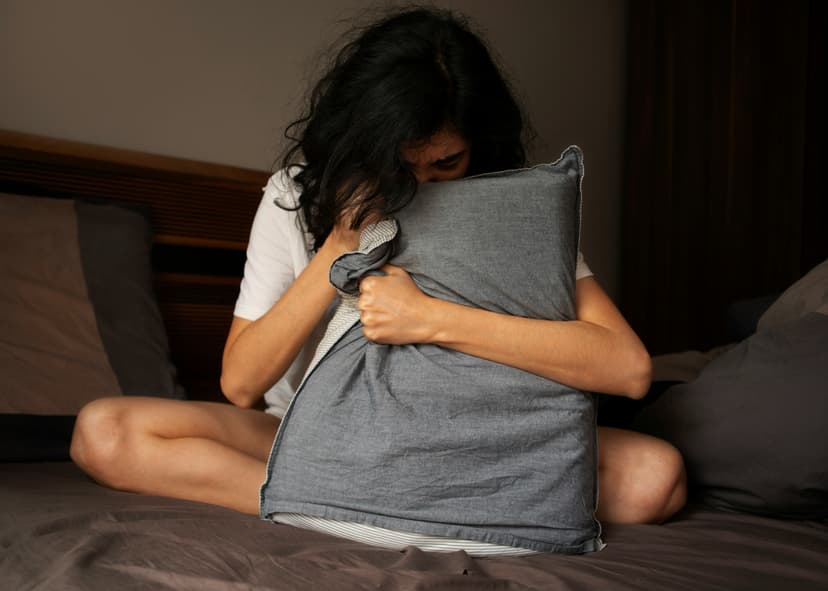How to Get Rid of Period Pain and Cramps Quickly and Effectively
Stop period pain fast with science-backed relief. Learn causes of menstrual cramps, heat and NSAID tips, long-term lifestyle strategies, and brain-based neurotechnology (tDCS) to retrain pain via neuroplasticity.

If you are looking for how to get rid of period cramps, you are likely familiar with the monthly disruption. You have probably lost days to pain that dictates your schedule, forcing you to cancel plans and push through work. You deserve an alternative that offers more than temporary menstrual period cramps relief.
A truly effective way to stop period cramps involves looking beyond the uterus and focusing on the control center for your entire body. Lasting relief comes from the connection between your menstrual cycle and your brain. What follows is not another list of common menstrual pain remedies.
What follows is a new perspective, grounded in science, explaining how your brain's response to pain can be retrained for a future with fewer interruptions.
What Really Causes Menstrual Cramps? (It’s Not Just Your Uterus)
The familiar throbbing pain of menstrual period cramps begins with prostaglandins. Your body produces these hormone-like substances to make the uterus contract and shed its lining. An overproduction of prostaglandins leads to more intense contractions and, therefore, more pain.
But the story does not end there. Pain itself is not created in the uterus. Pain is an experience constructed and interpreted by your brain. While prostaglandins send the initial signals, your brain is what processes them and determines the level of pain you feel. Over time, through the monthly repetition of pain, your brain can become highly efficient at creating this pain experience. A process known as central sensitization occurs.
The neural pathways for pain become stronger, creating a learned response that can amplify pain signals. For many, pain can feel more severe over the years as a result of these central nervous system changes, as noted in a critical review of primary dysmenorrhea. A better way to avoid period pain requires addressing this brain component directly.
Immediate Relief for When Cramps Strike
When you are in the middle of a painful period, you need solutions that work quickly. Here are some of the most effective methods for immediate menstrual period cramps relief.
1. Apply Heat
Using a heating pad, hot water bottle, or taking a warm bath can provide significant relief. Heat helps relax the muscles of the uterus, which can ease the intensity of the contractions. Applying heat to your lower abdomen can also increase blood flow to the area, further reducing pain. For many, the comfort of warmth is one of the fastest ways to feel better.
2. Take Over-the-Counter Pain Relievers
Nonsteroidal anti-inflammatory drugs (NSAIDs) are often recommended for menstrual pain because they directly target the cause. Medications like ibuprofen and naproxen work by lowering the production of prostaglandins in your body.
Actionable Tip: For the best results, take NSAIDs at the first sign of your period or as soon as you feel cramps starting. Taking them before the pain becomes severe can be more effective at keeping prostaglandin levels down. Always follow the dosage instructions on the package and consult a pharmacist or doctor if you have other health conditions or are taking other medications.
Lifestyle Adjustments for Long-Term Relief
While immediate remedies are crucial, certain lifestyle habits can help reduce period cramps over the long term, making your periods more manageable each month.
3. Stay Hydrated
Drinking enough water might seem simple, but it can help reduce bloating, which often makes cramping feel worse. Aim to drink plenty of water throughout the day, especially in the days leading up to and during your period.
4. Focus on Anti-Inflammatory Foods
Since prostaglandins contribute to inflammation and pain, eating a diet rich in anti-inflammatory foods can be beneficial. Try incorporating foods like:
- Omega-3 rich foods: Salmon, walnuts, and flaxseeds.
- Fruits and vegetables: Berries, leafy greens, and broccoli are packed with antioxidants.
- Herbal teas: Teas like ginger and chamomile have anti-inflammatory properties and can have a soothing effect.
At the same time, try to limit foods that can increase inflammation, such as processed foods, sugary treats, and excessive caffeine.
5. Move Your Body
When you are in pain, exercise might be the last thing on your mind, but gentle movement can be one of the most effective menstrual pain remedies. Physical activity releases endorphins, which are your body’s natural painkillers. Exercise also improves blood flow. You do not need an intense workout; gentle activities are very effective.
Actionable Tip: Try light walking, cycling, stretching, or yoga. Certain yoga poses, like Child's Pose and Cat-Cow, are particularly good for releasing tension in the lower back and abdomen.
6. Try Dietary Supplements
Some studies suggest that certain vitamins and minerals can help with menstrual pain. Consider talking to your doctor about adding these to your routine:
- Magnesium: Known as a muscle relaxant, magnesium may help ease uterine contractions.
- Vitamin B1 (Thiamine) and Vitamin E: Both have been shown in some studies to help reduce the severity of cramps.
- Omega-3 Fatty Acids: These can help lower inflammation throughout the body.
7. Reduce Stress
Stress can make pain feel worse. When you are stressed, your body releases cortisol, a hormone that can increase inflammation and your perception of pain. Finding ways to manage stress, especially in the week before your period, can make a difference.
Actionable Tip: Practice mindfulness, deep breathing exercises, or meditation. Even taking a few minutes for a quiet activity you enjoy can help lower stress levels and make pain more manageable.
8. Consider Massage
Gently massaging your lower abdomen in a circular motion can help relax the uterine muscles and alleviate cramping. You can also use essential oils like lavender or clary sage, diluted in a carrier oil, for added soothing effects.
When Period Pain Is More Than Just Cramps: Understanding Underlying Conditions
For some, severe pain is a sign of an underlying condition. A proper diagnosis is important.
- Endometriosis: This chronic condition affects an estimated 1 in 10 women, yet diagnosis is often delayed by an average of 7 to 10 years . Tissue similar to the uterine lining grows outside the uterus, causing significant pain and inflammation.
- PMDD (Premenstrual Dysphoric Disorder): A severe form of PMS with debilitating symptoms, understood to be a neurological sensitivity to normal hormone fluctuations .
Even with these conditions, your brain's processing of pain remains a critical factor. Brain-based therapies can offer significant relief by managing the pain response. The Samphire app can help track complex symptoms associated with these conditions, providing valuable insights for you and your doctor . As one user, Katie, who has both endometriosis and PMDD, shared, "I am really impressed, it has really helped. Also my PMDD symptoms have been helped" .
Medical Options and When to See a Doctor
If at-home remedies are not providing enough relief, or if your pain is severe, it is important to speak with a healthcare provider.
Hormonal Birth Control
For some, hormonal contraceptives like the pill, patch, or hormonal IUD can be an effective way to reduce period cramps. These methods often work by thinning the uterine lining, which leads to a lower production of prostaglandins, or by preventing ovulation altogether.
Investigating Underlying Conditions
While some period pain is normal, severe, debilitating pain is not. If your pain is consistently intense, getting worse over time, or accompanied by other symptoms like heavy bleeding or pain during sex, it could be a sign of an underlying condition. This is known as secondary dysmenorrhea.
Conditions that can cause severe period pain include:
- Endometriosis: A condition where tissue similar to the uterine lining grows outside the uterus.
- Uterine Fibroids: Noncancerous growths in the wall of the uterus.
- Adenomyosis: A condition where the uterine lining grows into the muscular wall of the uterus.
- Pelvic Inflammatory Disease (PID): An infection of the female reproductive organs.
A doctor can help determine the cause of your pain and recommend the most appropriate treatment plan. Do not hesitate to advocate for yourself and seek a medical opinion if you feel your pain is more than just "normal" cramping.
Why Over-the-Counter Pills and Hormones Aren’t a Complete Solution
When you need to stop period cramps, reaching for painkillers or hormonal birth control feels like the logical first step. These are standard treatments, but they have significant limitations.
Painkillers like ibuprofen work by blocking prostaglandins. They offer temporary relief but do not work for everyone and can come with side effects. Crucially, they do nothing to address the underlying brain sensitization that makes pain feel so intense. Hormonal birth control can reduce period cramps by suppressing your natural cycle, but many women seek a hormone-free and drug-free alternative to avoid side effects or to work with their body’s natural rhythm .
Neither of these common approaches targets the brain's learned pain response. They are temporary fixes that fail to address the root of why the pain feels so severe, leaving you searching for better menstrual pain remedies month after month.
How to Stop Period Cramps with Brain-Based Neurotechnology
You can train your brain to respond to pain differently using targeted technology., Nettle™ is a breakthrough wearable device that represents a new frontier in menstrual period cramps relief. Nettle™ is a certified medical device that uses a safe, non-invasive, and well-researched form of brain stimulation called transcranial direct current stimulation (tDCS). In a simple 20-minute session at home, the device delivers a gentle current to the two key brain regions involved in pain processing and mood regulation.
This is not a painkiller. This is a brain training tool. The device works with your brain’s neuroplasticity to gradually retrain your pain response and sensitivity over time . Clinical trials have shown this technology can significantly reduce menstrual pain intensity and duration. One user, Alice, who has endometriosis, noted after her first cycle, "First period was significantly less painful, I still took feminax but only once on day 1!" .
Harnessing Neuroplasticity: Retraining Your Brain for Lasting, Drug-Free Relief
The concept of neuroplasticity is the foundation for achieving lasting relief . Your brain is not static; it constantly adapts. You can use this adaptability to create enduring change in your pain experience.
Many people are familiar with TENS machines, like Livia, which work by sending electrical pulses to block pain signals at the nerve level near the source of pain . Think of a TENS unit as a temporary gatekeeper, stopping the signal from reaching the brain. Nettle™ works differently. Instead of blocking the signal locally, it works directly on the brain’s processing center. The device does not just block pain; it helps retrain the brain to react less intensely in the first place, leading to a more fundamental and lasting change for both pain and mood processing.
Using Nettle™ consistently is not just masking a symptom. You are actively rewiring your brain's pain response system. The benefits build over time, creating a new normal where pain no longer dominates your cycle.
Lifestyle Strategies to Support Your Brain and Body During Your Period
While neurotechnology provides a powerful tool, you can enhance its effects with lifestyle strategies that support your brain’s health and resilience. The first step is gaining a deeper awareness of your body's unique patterns.
The Samphire app is designed to help you integrate these habits and insights. As the only brain-first menstrual health app, it allows you to track symptoms in your own words, identify your unique patterns, and receive personalized activities to support you through every phase of your cycle . High-quality sleep is essential for brain health and pain modulation. Gentle exercise releases endorphins, your brain’s natural pain relievers.
Foods rich in omega-3s and magnesium can help reduce inflammation and relax uterine muscles. Simple, deep breathing exercises can also activate your parasympathetic nervous system, calming your body’s stress response. The app helps you discover which of these strategies works best for you.
Take Back Your Life from Period Pain
You do not have to lose days every month to menstrual pain. Lasting and effective menstrual pain remedies are possible when you shift your focus to the body’s control center, the brain.
Combining advanced neurotechnology with personalized insights gives you the tools needed to work with your body, retrain your brain, and stop letting pain dictate your life. Feeling your best in every phase of your cycle is achievable.
Ready to stop letting period pain run your life? Get the Nettle™ wearable and download the Samphire app to start your journey toward brain-based relief. If you’re based in the US, check out the Lutea™ neurotechnology device for balance. Try it risk-free for 90 days.
Frequently Asked Questions
How can I get quick relief when cramps start?
For immediate relief, applying heat to your lower abdomen can relax uterine muscles. Over-the-counter NSAIDs like ibuprofen can also work quickly by reducing prostaglandin production. These methods are effective for managing acute pain in the moment.
Can lifestyle changes really reduce cramps over time?
Yes. Regular, gentle exercise releases endorphins, your brain's natural painkillers. An anti-inflammatory diet rich in omega-3s can lower the prostaglandin response. These habits support your brain and nervous system, making them more resilient to pain signals over time.
Why aren’t painkillers or birth control enough for lasting relief?
These solutions do not address the brain's role in pain. Painkillers offer a temporary block, and hormonal birth control suppresses your natural cycle. Neither retrains the central sensitization in your brain, which is the learned amplification of pain signals that can develop over years of monthly cramps.
Do stress and lack of sleep worsen period cramps?
Absolutely. Both stress and poor sleep increase cortisol levels in your body. High cortisol makes your nervous system more sensitive, which can cause your brain to amplify pain signals. Managing stress and prioritizing sleep, especially before your period, can significantly reduce cramp severity.
Can period pain get worse with age?
Yes, it is common for period pain to worsen, particularly in your late 30s and 40s. This happens for two main reasons: the hormonal shifts of perimenopause can make your cycle more irregular and intense, and years of repeated monthly pain can lead to central sensitization, where your brain becomes more efficient at creating the sensation of pain.
What are the most effective home remedies for period pain?
Heat application is one of the most effective and fastest-acting home remedies. Gentle stretching or yoga can release muscle tension in the abdomen and lower back. Practicing mindfulness or deep breathing can also calm the nervous system, which helps lower your perception of pain. All of these can be combined with our range of neurotechnology solutions.
Which foods help reduce menstrual cramps naturally?
Foods rich in magnesium, like dark chocolate, nuts, and leafy greens, help relax muscles. Anti-inflammatory foods containing omega-3 fatty acids, such as salmon and walnuts, can help reduce the production of pain-causing prostaglandins.
Does exercise actually help during your period?
Yes, gentle exercise is very helpful. Activities like walking, swimming, or light yoga increase blood flow and trigger the release of endorphins. Endorphins are powerful brain chemicals that act as natural pain relievers, helping to ease cramps.
Related Articles

Why does my period feel different from last month?
Have you ever wondered why your period can vary so much? Learn about the science behind it.

Cortisol, stress and the menstrual cycle
Learn how cortisol affects your brain, why stress can become chronic, and how your menstrual cycle may shape stress response.

The menstrual pain-brain connection
Pain is not just a symptom. It's a complex experience deeply influenced by biological, psychological, and social factors. Pain is also notoriously difficult to measure